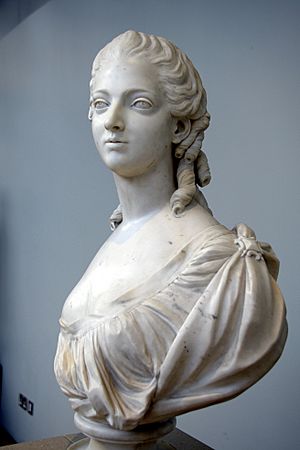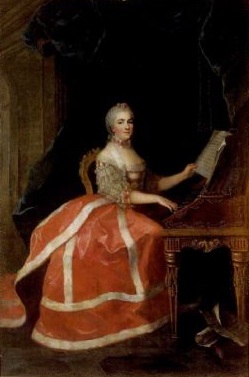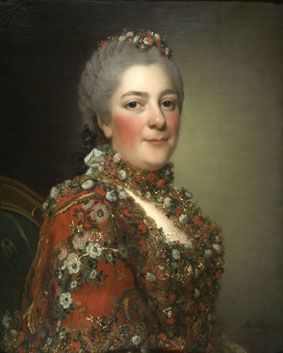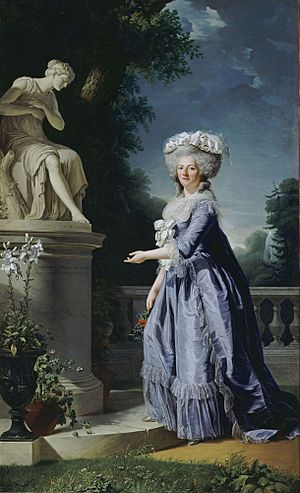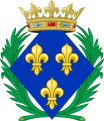Victoire of France (1733–1799) facts for kids
Quick facts for kids Victoire of France |
|||||
|---|---|---|---|---|---|
| Princess of France | |||||
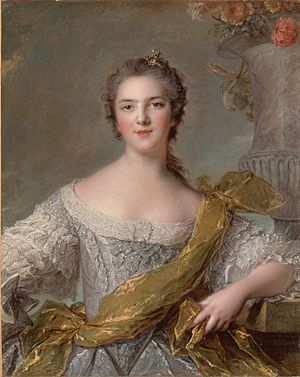
Portrait by Jean-Marc Nattier, 1748
|
|||||
| Born | 11 May 1733 Palace of Versailles, Versailles, Kingdom of France |
||||
| Died | 7 June 1799 (aged 66) Trieste, Archduchy of Austria, Holy Roman Empire |
||||
| Burial | 20 January 1817 Basilica of Saint-Denis |
||||
|
|||||
| House | Bourbon | ||||
| Father | Louis XV | ||||
| Mother | Marie Leszczyńska | ||||
| Signature | |||||
Victoire of France (full name: Marie Louise Thérèse Victoire; born May 11, 1733 – died June 7, 1799) was a French princess. She was the daughter of King Louis XV and Marie Leszczyńska. She was named after her parents and her great-great-grandmother, Queen Maria Theresa.
When she was born, Victoire was known as Madame Quatrième. This meant she was the King's fourth daughter. An older sister, Marie Louise, had died before Victoire was born. Later, she became known simply as Madame Victoire. She lived longer than eight of her nine brothers and sisters. Her older sister, Madame Adélaïde, passed away less than a year after Victoire. These sisters were often called Mesdames.
Contents
Life as a Princess
Early Years and Education
Princess Victoire was born at the grand Palace of Versailles on May 11, 1733. She was the seventh child and fifth daughter of King Louis XV of France and Queen Maria Leszczyńska.
Unlike her older brothers and sisters, Madame Victoire was not raised at Versailles. In June 1738, she was sent to live at the Abbey of Fontevraud with her younger sisters. This was because the King's chief minister, Cardinal Fleury, thought it was too expensive to raise them at Versailles. She stayed there until 1748, when she was 15 years old.
Life at the Abbey of Fontevraud was quite different from court. The princesses did not receive much formal education there. One of her sisters, Madame Louise, later said she barely knew the alphabet at age twelve. Madame Victoire herself said that she had moments of great fear at the Abbey. This happened when she was sent to pray alone in the vault where the nuns were buried.
Life at Court with Louis XV
On March 24, 1748, when she was fifteen, Victoire wrote to her father. She asked for permission to return to the royal court. The King agreed. She was joined by her younger sisters, Sophie and Louise, in November 1750.
When they arrived at court, they were given their own royal staff. Their education had been overlooked at the convent. But they made up for it by studying a lot after returning to court. Their brother, the Crown Prince, encouraged them. They learned to write French well and studied history. They also learned Italian, English, and even higher mathematics.
Victoire was very popular at court. She was lively, confident, and charming. People thought she was beautiful. She was described as having "beautiful, tender, soft brown eyes" and a "bright smile." She seemed happy and healthy, and she always wanted to please others.
In 1753, there was a suggestion that she might marry Ferdinand VI of Spain. His wife was very ill at the time. However, the Queen of Spain recovered and lived for five more years. Victoire never found another suitable husband and remained unmarried. Over time, she became quite heavy. Her father, the King, even gave her the playful nickname ‘Coche’ (which means 'Piggy').
Victoire was very close to her brother and looked up to her mother. She also supported her sister Madame Adélaïde in their dislike of the King's mistresses, Madame de Pompadour and later Madame du Barry. She was known for being "good, sweet-tempered, and friendly." People at court and her staff liked her very much.
Around 1770, the princesses had a daily routine. King Louis XV would visit them each morning. He often brought coffee that he had made himself. The sisters would gather in Madame Adélaïde's apartment for this visit. In the evenings, at six o'clock, they would visit the King again. This visit was called the King's 'debotter', meaning the time he took off his boots. For this, they would put on fancy dresses with large hoops and long trains. They would cover their casual clothes with a black cloak. Many staff members, carrying torches, would go with them to the King. The King would kiss each princess on the forehead. These visits were very short, often lasting only fifteen minutes.
In 1770, Marie Antoinette became the Dauphine (Crown Princess). She married Madame Victoire's nephew, who would become Louis XVI of France. Marie Antoinette was initially close to the Mesdames. They were the most senior royal women at court. However, their close relationship ended in 1772. This happened after the Mesdames tried to get Marie Antoinette to embarrass Madame du Barry.
Life During Louis XVI's Reign
From April 1774, Madame Victoire and her sisters cared for their father, Louis XV, as he lay dying from smallpox. Even though the sisters had never had smallpox, they stayed with him until he died on May 10. Other male members of the royal family were kept away because of the high risk of getting sick. The princesses were allowed to stay because they were women and not in line for the throne.
After Louis XV died, his grandson Louis-Auguste became Louis XVI of France. He called his aunts Mesdames Tantes (meaning 'Aunt Princesses'). The sisters did get smallpox from their father but recovered. They were kept in quarantine in a small house near the Palace of Choisy.
The new King allowed them to keep their apartments at the Palace of Versailles. They still attended court for special events. However, they often preferred to live at their own Château de Bellevue in Meudon. They also traveled every year to Vichy for its waters. They always brought a large group of about three hundred people with them.
The Mesdames did not get along well with Queen Marie Antoinette. The Queen started new, less formal customs at court. This made many older noble families unhappy. These nobles often gathered at the salon (a social gathering) of the Mesdames. Their salon at Bellevue and Versailles was a place where people who opposed Marie Antoinette met. They even allowed poems that made fun of the Queen to be read there. The Mesdames also supported a very traditional group of nobles who were against new ideas.
Revolution and Later Life
Madame Victoire and her sister were at Versailles during the Parisian women's march to Versailles on October 6, 1789. They were with the King's family when the palace was attacked. They left Versailles in a carriage train heading for Paris. However, their carriage separated from the others. They never lived at the Tuileries Palace with the royal family. Instead, they moved to the Château de Bellevue in Meudon.
New laws against the Catholic Church made them want to leave France. They asked the King for permission to travel to Saint Peter's Basilica in Rome for a pilgrimage. Louis XVI signed their passports.
On February 3, 1791, as they were about to leave, a group called the Jacobin Club found out. They protested to the National Assembly. On February 19, a crowd of women gathered to stop the Mesdames from leaving Bellevue. But the princesses were warned and left quickly in a visitor's carriage. Their baggage wagons were sent after them. They left for Italy on February 20, 1791, with many people in their group.
Their trip caused a lot of discussion in the newspapers. Some papers joked about their sudden desire to travel. Others criticized them for taking a lot of money with them. Their journey was not easy. They were stopped temporarily by a riot in Moret. On February 21, they were held for several days in Arnay-le-Duc. The local government wanted to confirm their permission to leave from the National Assembly. In Paris, this caused more riots. Protesters demanded that the King order his aunts to return. The National Assembly debated the issue. A speaker named Mirabeau convinced them that the princesses' trip would not harm the country. The public in Arnay-le-Duc was still unhappy. Because of a riot, the sisters could not leave until March 3.
They faced more protests between Lyon and the border. But they finally left France, crossing into Savoy. They were welcomed with artillery fire from the Italian side. They were met by a royal guard and officials from the King of Sardinia. They stayed at the Chateau de Chambery. They also visited their niece Clotilde at the royal court in Turin. But they only stayed for two weeks. Madame Victoire cried a lot, and Madame Adélaïde was almost unable to speak, because they were so worried about their family and country.
They arrived in Rome on April 16, 1791. They stayed there for about five years, protected by the Pope. They lived in the palace of Cardinal de Bernis. A writer named Cornelia Knight described them as kind and respected by the Romans. She noted that they had sold their jewels to help poor French people who had also left France. When news came that Louis XVI and his family had tried to escape Paris, there was a misunderstanding that they had succeeded. Rome celebrated, and the Mesdames held a big banquet. But they had to stop when it was clear the escape had failed.
When Revolutionary France invaded Italy in 1796, Adélaïde and Victoire left Rome. They went to Naples, where Marie Antoinette's sister, Maria Carolina, was queen. They lived at the Neapolitan royal court in the Palace of Caserta. Queen Maria Carolina found their presence difficult because they brought a large group of eighty people and kept many old court traditions.
When Naples was invaded by France in 1799, they left for Corfu. Finally, they settled in Trieste, where Victoire died of breast cancer. Adélaïde died one year later. Their bodies were returned to France by Louis XVIII during the Bourbon Restoration. They were buried at the Basilica of Saint-Denis.
Images for kids
-
Madame Adélaïde also by Jean-Marc Nattier as air
See also
 In Spanish: Victoria de Francia para niños
In Spanish: Victoria de Francia para niños
- Mesdames de France


